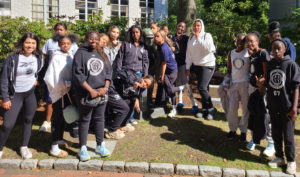On Saturday, September 19th, we had our first field trip of the 2022-2023 academic school year! Working with our partner organization, Ron Burton Training Village, we hosted 60 girls (grades 6-12) for a day focused on AI/energy and policies thereof. Thank you to all STEM volunteers who attended today, including two completely new volunteers(*): Karen, Erika, Zandria, Franklin, Emina*, Olivia*!!
Our (Center for STEM Education) new associate director, Jennifer Love, taught students about algorithms and artificial intelligence. Thereafter, students worked in teams to make sumo wrestling hexbugs – hexbugs are little robots that utilize a rotating motor to randomly move around. Students were given an index card, scissors, and scotch tape and told to modify their hexbug in a way that makes their hexbug more likely to stay within the arena – students added various pikes, spikes, and other protuberances to their hexbugs to push and prod their competitors out of the arena!
After a short break, students learned about renewable energy and circuits – specifically focused around solar energy and learning about absorption, reflection, and transmission. Students started with an activity in which they measured the effects of different colors of paper, mirrors, magnifying glasses, and aluminum foil on the energy generation of a solar panel. They learned that solar panels are not quite as efficient as they thought – our solar panels produced between 0.3 and 1.6 volts of energy, so ~1/5 to 1/1 on par with AA and AAA batteries. This tracks, our solar panels were approx 2″x3″, whilst in the real world solar panel arrays tend to be very large and cover entire roofs or fields. Students determined that darker colors tended to absorb more sunlight whilst lighter colors (and mirrors) reflected more sunlight. Increasing the efficiency of their solar panels was done by concentrating as much sunlight onto their solar panels and ensuring the least amount of light escaped (and thus didn’t reach their panels).
Next, students used their newfound knowledge to design and build solar ovens – each to cook 3 s’mores at a time. Given pizza boxes, different colors of paper, clear wrap, tape, string, and markers – students used the engineering design process to come up with – in their ideas – most efficient designs. We then went outside and put the boxes in the sun to cook. Outside temperature was 65 degrees F, s but the sky was clear, so after ~45 minutes, the chocolate had melted in many of the ovens! Some designs were clearly more efficient than others, particularly those that closed and kept the heat inside.
After an RBTV-led exercise, students sat in small groups with Franklin, Emina, Zandria, and Karen and asked questions about college, science, engineering, and more, whilst eating lunch.
The day wrapped up with an hour-long campus-wide scavenger hunt. As an additional stop, students visited the NU Mars Rover team!









